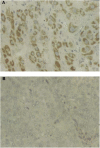Genomic analysis reveals RhoC as a potential marker in hepatocellular carcinoma with poor prognosis
- PMID: 15150600
- PMCID: PMC2409518
- DOI: 10.1038/sj.bjc.6601749
Genomic analysis reveals RhoC as a potential marker in hepatocellular carcinoma with poor prognosis
Abstract
Hepatocellular carcinoma (HCC) is one of the most malignant human tumours because of its high incidence of metastasis. The mechanisms underlying the metastasis of HCC, however, remain poorly understood. In this study, we performed cDNA microarray analysis to profile gene expression patterns in two subtypes of HCC, solitary large HCC (SLHCC) and nodular HCC (NHCC), which differ significantly in the incidence of metastasis. Among 668 genes that were differentially expressed, we focused on RhoC, whose expression was significantly decreased in SLHCC compared to NHCC. The expression of RhoC in HCC and pericarcinomatous liver tissues (PCLT) was analysed at both the mRNA and protein levels by reverse transcription-polymerase chain reaction (RT-PCR) and Western blotting. In addition, immunohistochemistry was also performed on 94 cases of HCC with follow-up information. Collectively, our data indicate that the expression of RhoC significantly increased in HCC compared to PCLT; extrahepatic metastatic lesions expressed significantly higher levels of RhoC than the corresponding intrahepatic HCC tissues. There is a highly significant correlation of the RhoC expression levels with tumour vein invasion, number of tumour nodes and the status of differentiation. Significantly, the HCC patients with RhoC-positive expression had shorter survival than those with RhoC-negative expression. Together, our findings suggest a strong correlation between the expression of RhoC and HCC metastasis, implicating RhoC as a potential prognosis marker and therapeutic target for HCC.
Figures





References
-
- Akriviadis EA, Llovet JM, Efremidis SC, Shouval D, Canelo R, Ringe B, Meyers WC (1998) Hepatocellular carcinoma. Br J Surg 85: 1319–1331 - PubMed
-
- Clark EA, Golub TR, Lander ES, Hynes RO (2000) Genomic analysis of metastasis reveals an essential role for RhoC. Nature 406: 532–535 - PubMed
-
- El-Assal ON, Yamanoi A, Soda Y, Yamaguchi M, Yu L, Nagasue N (1997) Proposal of invasiveness score to predict recurrence and survival after curative hepatic resection for hepatocellular carcinoma. Surgery 122: 571–577 - PubMed
Publication types
MeSH terms
Substances
LinkOut - more resources
Full Text Sources
Medical

